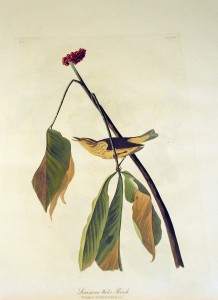 “Much and justly as the song of the Nightingale is admired, I am inclined, after having often listened to it, to pronounce it in no degree superior to that of the Louisiana Water Thrush. The notes of the latter bird are as powerful and mellow, and at times as varied.
“Much and justly as the song of the Nightingale is admired, I am inclined, after having often listened to it, to pronounce it in no degree superior to that of the Louisiana Water Thrush. The notes of the latter bird are as powerful and mellow, and at times as varied.
This bird is a resident of the low lands of the states of Louisiana and Mississippi, and is to be found at all seasons in the deepest and most swampy of our cane brakes, from which its melodies are heard to a considerable distance, its voice being nearly as loud as that of the Wood Thrush. The bird may be observed perched on a low bough scarcely higher than the tops of the canes, in an erect attitude, swelling its throat, and repeating several times in succession sounds so approaching the whole two octaves of a good piano-forte, as almost to induce the hearer to imagine that the keys of that instrument are used on the occasion. The bird begins on the upper key, and progressively passes from one to another, until it reaches the base note, this last frequently being lost when there is the least agitation in the air. Its song is heard even in the winter, when the weather is calm and warm.
[Of the Indian Turnip, upon which this bird is perched] . . . The flowers are green and purple, and the roots are used by Indians as a remedy for colic.”